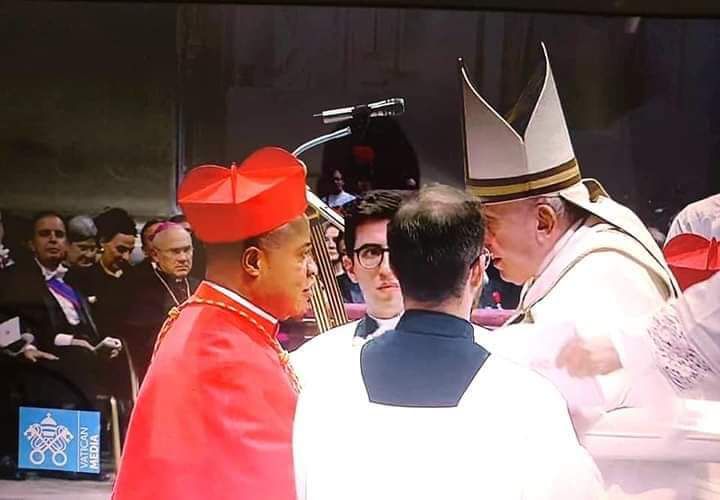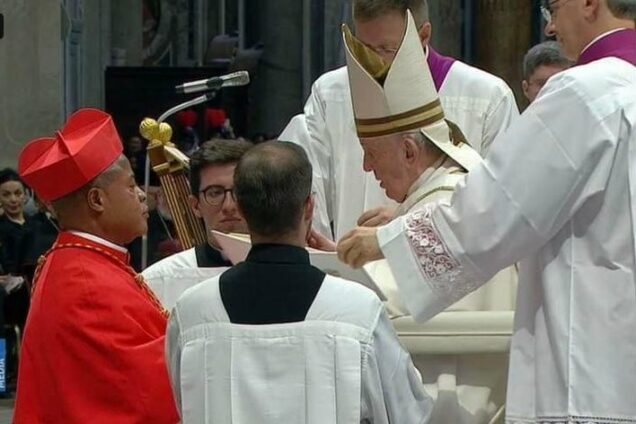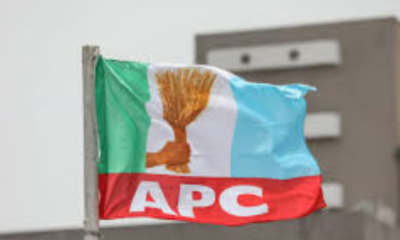Comments and Issues
Okpaleke and the Journey to Rome
Published
2 years agoon
By
Publisher
By Valentine Obienyem
The journey to Rome was pleasant and joyous: a Nigerian and the Bishop of Ekwulobia, Most Rev. Dr. Peter Okpaleke was among the 20 Cardinals so-created by Pope Francis. It was really a glorious interlude for a country where news items are subsumed in the shocking – kidnapping, beheading, rape and rapine. There is no vocabulary of decadence that is not accommodated by our dear country.
Indeed, one of those afore-mentioned shocking news was the rejection ten years ago (7th December, 2012) by Ahiara Diocese of Bishop Okpaleke’s appointment as their Bishop and his prevention from canonical possession of the Diocese. This led to his resignation on 19th February, 2018.
At a point, when seen through the prisms of the world, he was considered as the most tortured Bishop in Nigeria, he did not appear so, but continued to pursue his episcopate. When he was eventually appointed a Cardinal, joy was universal. It appears to be the Pope’s unique method of lifting one up as an example of Christian living, apostolic patience and deep humility.
It is by no means easy to appoint a Cardinal. During the 1563 Ecumenical Council of Trent, Pope Pius IV exposed to us the minds of Popes when appointing Cardinals. His words:”Nothing is more necessary to the Church of God than that the Holy Roman Pontiff apply that solicitude which by the duty of his office he owes the universal Church in a very special way by associating with himself as cardinals the most select persons only, and appoint to each church most eminently upright and competent shepherds; and this the more so, because our Lord Jesus Christ will require at his hands the blood of the sheep of Christ that perish through the evil government of shepherds who are negligent and forgetful of their office”. Cardinal Okpaleke was appointed due to the plenitude of Apostolic virtues.
The fore-going explains why over 300 Nigerians from across the Federation attended the Consistory at which Opkaleke received the Red Hat. The organisation of the event was itself superb. Professor Fr. Anthony Chiegboka, Fr. Christian Umeojinaka, Fr. Lawrence Nwankwo, Fr. Michael Muonwe, Fr. Nicolas Abazie, among other priests were at their best. Even in a horriedly written pice, my I recognize the presence of Fr. Emmanuel Udechukwu. Before other priests I did not mention their names, including some of my old teachers will start raising objections, May I inform them that I served Fr. Emmanuel Udechukwu at mass in the early eighties. He in fact took me to the seminary for registrations at Akpu.

Thanks to the organisers, some of who I had mentioned for maximizing the trip. Rather than pay millions of Naira to partake in the Consistory only, they artfully turned it into a pilgrimage. Thus, the opportunity was taken to visit the historic and religious sites of Rome. Some of us even sallied forth beyond Rome. I read what Fr. Augustine Nnadi wrote about the visit to his lover – St. Maria Goretti. Those of us in love with classics, went as far as Naples, where I visited the ruins of Pompeii, a UNESCO heritage site, as well as Mt. Vesuvius, which erupted in AD 79 and with the molten magma that escaped its confines, buried the city of Pompeii that was later excavated. In spite being an active volcano, why does the Italian Government still allow people to live within the vicinity of that catastrophe?
However, since our visit was primarily about the Cardinalet, let us do a little exposition for fuller understanding and appreciation of the lofty position our brother has been elevated to, being effectively the Prince of the Church.
Lend your ears to experts in Church history they would tell us that time was when even laymen were appointed Cardinals. They would tell us about so many changes that institution had undergone, with different Popes promulgating various bulls to effect those changes. An example was In 1059, when through the bill entitled “In Nomine Domini”, Pope Nicholas XII granted Cardinals the right to elect new Popes. We have even seen Popes exercising their powers to set aside Church Laws by appointing more Cardinals than prescribed.
The point to note here is that the Sacred College, also called the College of Cardinals, is very important in the lives of Popes. This body acts as advisers to the Pope. He, in the spirit of apostleship, asks their advice whenever needed.
We have three classes of Cardinals, namely: Cardinal Deacons, Cardinal Priests and Cardinal Bishops. Cardinal Deacons from where Francis Cardinal Arinze started, are either officials of Roman Curia or priests who at over 80 years are no longer qualified for the Conclave. Cardinal priests, which are the designations of other Nigerian Cardinals like our own Okpaleke, are mostly Diocesan bishops though some are also Curia Cardinals. Cardinal Bishops which Francis Cardinal Arinze eventually became are the highest-ranking cardinals who were appointed titular Bishops of one of what is called Suburbicarian Sees as in that of Velletri-Segni for Arinze.
The Pope meets the Cardinals officially in the consistories. Consistories could be secret, semi-secret or public.
It is at secret consistories that new Cardinals are named; and the Pope gives them their sapphire rings as a symbol of their offices. If a Cardinal comes from a far country, the Pope assigns him an honorary position as the head of a diocese in Italy. Okpaleke is the Cardinal priest of Santi Martiri dell’ Uganda a Poggioreale Ameno, with which he would maintain a titular relationship. At secret consistories, the Pope creates Cardinal Camerlengo, that is, Chancellor of the Catholic Church. Assisted by the Vice-Camerlengo, they head the office known as the Apostolic Camera. The Camerlengo’s function is limited to the period of “Sede Vacante”, when he expectedly presents the state of the finances of the Papacy to the College of Cardinals, as they gather for the Conclave.
In semi-public consistories, the Pope, Cardinals and Bishops meet. This consistory discusses candidates for beatification and canonization. It took place on the 27th, immediately after the reception of red hats by the new princes.
It is pertinent to note here that Popes sometimes appoint Cardinals “in Pectore”; that is secretly to avoid his being victimized in places the Church is under persecution. If not named publicly, his position expires with the death of the Pope, otherwise he takes position based on when he was appointed.
The major function of the College of Cardinals is the election of a new Pope. This was done by only Cardinal Bishops until 1179, when the Third Lateran Council extended it to the entire body of Cardinals.
When a Pope dies, a member of the College must verify his death. He touches the forehead of the Pope thrice with a silver mallet and calls him by his baptismal name. He then announces that “the Pope is truly dead”. In the interim, the Sacred College takes over his functions.
During the election of a new Pope, the College of Cardinals is known as “The Conclave”. While in the conclave, the Cardinals severe any relationship with the outside world. On the day of the election, mass of the Holy Ghost is celebrated for guidance in decision-making. The actual voting takes place in the Sistine Chapel (erected in the Palace of the Vatican by Pope Sixtus IV in 1473). Some of us had the privilege of visiting the Chapel while in Rome.
The Conclave begins between the 15th and 18th day after the death of a Pope. After voting, if a new Pope is not elected, the scrutinies (ballots) are burnt with a mixture of straw) to produce black smoke. When eventually a Pope is elected, the straw is burnt alone to produce white smoke. Then, outsiders will shout “Viva il Papa” (“Long Live the Pope”). The Cardinals will then pay their first homage to the Pope-Elect. The senior Cardinal Deacon (Protodeacon) will then step out on the balcony of St. Peter’s Church and announce to the people in Latin: “Habemus Papam” (“We have a Pope”). The Pope makes his first appearance and gives his blessing: “Urbi et Orbi” (to the City and to the World”).
The Pope-Elect chooses a day and a place for his installation – they have often chosen St. Peter’s Church. On that day, the Pope is carried on a portable throne in a procession from the Vatican to Saint Peter. The Protodeacon places the “Pallium” on the new Pope and after the mass, places a three-tiered crown (Tiara) on the Pope’s head. He then gives his blessing. The Cardinals will pay a second homage.
However, in 1978, Pope Paul I eliminated many of these traditional ceremonies. He walked in the procession and chose to have a pallium placed over his shoulders, symbolizing his pastoral responsibilities as the head of the Church. Later, Pope John Paul II and other Popes followed the Pauline example.
The foregoing partly represents the operation of the papacy, so wonderfully organized. In fact, if art were the organization of government, the Papacy is the most imposing master-piece in history.
This does not mean that the papacy is perfect. It has its own troubles like other institutions manned by the sons of Adam. We have had Popes who were epitomes of moral degeneracy amidst many achievements. A parody book was written by Erasmus – the famous man regarded as having laid the reformation egg that Martin Luther eventually hatched – about a Pope, Julius II who, when he got to Heaven was prevented by St. Peter from entrance on account of his poor representation. Erasmus said he took the name Julius II not in honour of Julius I, but in emulation of Julius Caesar. In his book, “The Prince”, Machiavelli held him up as an ideal Prince.
Beyond witnessing on the 27th of August, 2022 with Cardinals Arinze and Onaiyekan the reception of the Red Hat by Peter Cardinal Okpaleke, we also explored the spiritual, political and artistic riches of Rome. It was another opportunity to observe how nations prepare themselves for greatness with whatever is available to them. Italians are making full use of their rich historical past by packaging them in tourism through which they make billions of Dollars annually. Has Nigeria as a country tried to harness things unique to her?
As we traversed Rome, we observed some key elements of the city. Determined that the Roman origin would not be outshone by rival lore, our guide told us how two twins, Remus and Romulus – half-history, half-myth, born at Castel Gandolfo by the mystery of history – came to Rome and established a city there.
The tale resonated when we visited the Pope’s summer residence at Castel Gandolfo, overlooking the beautiful and volcanic Lake Alban of 200 metres deep. For me, it was face-to-face with history having heard about Castel Gandolfo from our then Spiritual Director, the saintly Fr. Paul Nwaelom in the eighties. The scenic beauty of the lake tempts even those that do not know how to swim to jump into it. It has beautiful and attractive beaches. In Nigeria, such lakes would be centres of sacrifice to known and unknown gods!
At Castel Gandolfo we saw the old Church of St. Thomas of Villanova. Being on a Sunday, mass was going on. Our guide explained that the village is inhabited by 500 people and had, since 17th Century been used by the Popes until Pope Francis, who only visited the castle twice, turned it into a museum. This was how they stopped the customary complex and mystifying ceremony of installation of a new a Pope. Why strip the Church of little mysteries that clothe her with spiritual mystiques?
At Castel Gandolfo, we raised the issue of how meticulous Italians try to preserve their old landmarks. For Fr. Charles Umeoji, that is the soul of tourism. He is pained, like most of us how Nigerians destroy old memories for no cogent reasons. Because Fr. Umeoji lived in Germany for a long time, he is conversant with conservation and restoration. Let him tell us his experience: “When I wanted to renovate my Church in Germany, I had to, according to the law, inform the ‘Denkeschutz’. You do such subject to their approval which flows from one’s and commitment to use a certified restorer for the renovation”. In Nigeria, we have seen priests demolish Churches that would have today become tourist attractions for bigger, unneeded Churches.
From Castel Gandolfo we visited the town of Fracasti which our all-knowing guide described as the most popular town in Alban Hills known for wine and olive oil. Relating the true position of things at home, one of us said that in Italy, they use olive oil to cook, while in Nigeria, we use it for “casting and binding” the ubiquitous Satan. Fracasti hosts one of the Suburbicarian dioceses within the Cathedral of St. Peter. We also saw the Villa of Tusculum which now hosts reception for events.
On the 2nd day after the consistory, we took off to the Catacomb of Domitilla. Catacombs are part of the history of Christianity and remind us of what early Christians suffered and how they propagated and held on to their faith regardless.
Recall that history which knows everything, told us that the nascent Christianity was troubled on many fronts, especially from Roman Emperors. Being pagans, they tried to exterminate Christians at all cost. It was so intense that in AD 67, Emperor Nero killed St. Peter and St. Paul. When Rome burnt (AD 64-65), Nero accused and persecuted Christians. In AD 96, Emperor Domitan tried to surpass the records of Nero by his brutal killing of Christians, some by cudgeling. Emperor Diocletian in AD 303, 23rd February, published a general edict ordering the destruction of Christian Churches and writings and reduced Christians to slave status. The list of hostile acts, if one wishes, could go on ad-infinitum
The Catacomb of Domitilla was one of the places Christians secretly worshipped and buried their dead. It is the only Catacomb in Rome which has an underground Basilica dedicated to the Holy Martyrs, Nereo and Achilleo. There, we celebrated mass led by Fr. Anthony Chiegboka.
In spite of a brief relapse during the Emperorship of Julian nick-named the apostate, a turning point for Christians was, however, recorded in AD 314. With the help of his mother, St. Helena, Pope Sylvester (314-325) converted Constantine to Christianity. As a postscript, he initiated the transformation of pagan Rome into a Christian state. Constantine stopped the crucifixion and breaking of legs in the Roman Empire (AD 315); and declined to celebrate the “Ludi Saeculares” at Rome because of their pagan association (AD 314). Constantine exempted the clergy of Roman Empire from taxation (AD 315); recognized the jurisdiction of ecclesiastical courts (AD 318); forbade magic (AD 320); and prohibited heretical gatherings and divorce (AD 331). The culminating act of his conversion was the building of the first St. Peter’s Basilica above the crypt (tomb) of St. Peter in 325. The modern St. Peter’s Basilica was, however, started in 1506 by Pope Julius II and dedicated in 1626 by Pope Urban VIII. Pope Alexander VII (1655-1667) was to erect the magnificent colonnade of the plaza at St. Peter’s.
The tour of St. Peter really proved it as the biggest Church in the world. The inside is very expansive and magnificent. It is the burial site of over 100 persons, including Popes and notable individuals.
St. Peter’s Basilica is one of the papal basilicas and among the four major Basilicas of Rome. The other Major Basilicas (all of which are also Papal Basilicas) are the Basilicas of St. John Lateran, St. Mary Major and St. Paul Outside the Walls. We were exposed to the fact that the Archbasilica of St. John Lateran is highest in rank above St. Peter’s which is not actually a Cathedral. St. John Lateran is the seat of the Pope as the Bishop of Rome. The Pope holds most of the events that ordinarily should take place there at St. Peter’s because of its location – the Vatican. However, the other major basilicas and important buildings such as the Castel Gandolfo enjoy extra-territorial status.
Everywhere we went in Rome, we were faced with classical history, especially for those of us that studied with the “A New Approach to Latin”. Talk about the Colosseum, the Forum, Trajan Column, the Tiber as central to Rome as Seine to Paris, Arcs of Constantine, it was a worthwhile experience.
With the knowledge of classics, one easily noticed that some of the streets in Rome were named after famous people in Roman history, such as Aurelius, the philosopher-Emperor, and Gracchi, among others. I did not see the names of those who, in spite fighting to re-barbarise Rome like Julian, being conferred with such honour like in our clime, where the devil’s incarnates even achieve post-humous honour through the strength of the Naira.
Throughout our stay in Rome, most of us lamented the state of Nigeria, how a chasm exists between the development in Italy and our country. Some even made it a point of prayer that Mr. Peter Obi who was also in Rome should succeed as President and start building Nigeria as other statesmen do for their countries. “Imagine, since we arrived, I have not heard any driver sound the horn”, one of us observed. He was also marvelled at how vehicle drivers respect Pedestals.
Well-planned and very neat, one observed the mature taste of Italians. The music in their taxis are always calm and mellifluous, without any tinge of “ayaga yaga”. The are heavy smokers and some of them, tongue in cheek, appear to have learnt smoking before warning. Jealous and over protective of their women, they are also proud of their country and appear not to be interested in knowing about other countries. They remind us of a Moroccan traveller, who, after return from a trip to Europe, exclaimed “ What a comfort to return to civilization.”
Rome is about developing one’s strong points. They have so much developed tourism by realizing that it is its own unique investment. Even their tour guides are properly trained such that they understand the import of their trade. Beyond provision of employment, they talk about their country with cheeks bursting with pride.
All in all, the journey to Rome was fulfilling and humbling. Some of us who attended the reception at Urban University were moved to tears when Bishop Paulinus Ezeokafor spoke of the Cardinal as his son and assured him of his continued support and goodwill. Thought the highest ranking active prelate in Nigeria today, the Cardinal spoke at the occasion, and stylishly answered the most perplexing question that before then left enquirers scratching their heads in perplexity when he said “Archbishop Valerian Okeke remains my Metropolitan.”
At this juncture, we ask: what lessons do we learn from the trip to Rome? Like the wise one said, education comes one-fourth from school, one-fourth from others, one-fourth from ourselves and one-fourth from travel. As we return to Nigeria, may those of us privileged to ascend positions of leadership learn positive lessons from the trip.
Trending

 Football5 days ago
Football5 days agoGuardiola advised to take further action against De Bruyne and Haaland after both players ‘abandoned’ crucial game

 Aviation7 days ago
Aviation7 days agoNCAA suspends three private jet operators for engaging in commercial flights

 Aviation6 days ago
Aviation6 days agoDubai international airport cancels flights as flood ravages runway, UAE

 Comments and Issues4 days ago
Comments and Issues4 days agoNigeria’s Dropping Oil Production and the Return of Subsidy

 Featured3 days ago
Featured3 days agoPolice reportedly detain Yahaya Bello’s ADC, other security details

 Featured1 week ago
Featured1 week agoRelationship between Oyetola, Omisore remains cordial — Osun APC

 Business4 days ago
Business4 days agoMaida, university dons hail Ibietan’s book on cyber politics

 Education4 days ago
Education4 days agoEducation Commissioner monitors ongoing 2024 JAMB UTME in Oyo

